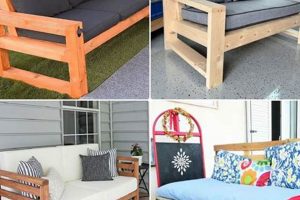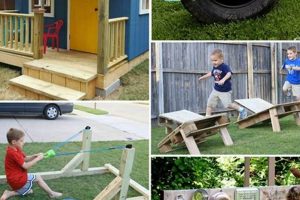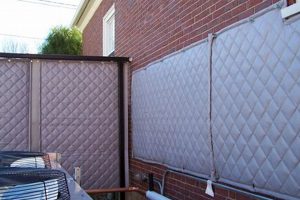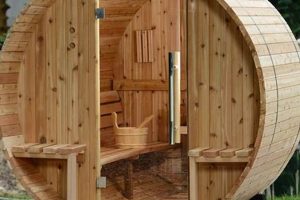Constructing personalized aquatic installations within residential landscapes constitutes a popular form of home improvement. These projects typically involve utilizing readily available materials and basic construction techniques to create aesthetically pleasing and functional water displays, often intended as focal points in gardens or patios. Examples range from simple container ponds and bubbling fountains to more elaborate tiered waterfalls and recirculating streams.
The appeal of creating these customized elements lies in the combination of cost-effectiveness, creative expression, and the environmental benefits they offer. These projects can significantly reduce expenses compared to purchasing pre-fabricated water features or hiring professional installers. Furthermore, they provide an outlet for individual design preferences and allow homeowners to tailor the installation to their specific space and needs. Historically, the integration of water into outdoor spaces has been valued for its soothing qualities, promoting relaxation and attracting wildlife, thus enhancing the overall outdoor experience.
The following discussion will delve into the various aspects of designing and implementing these projects, including planning considerations, material selection, construction methods, and essential maintenance practices. It will also cover safety precautions and best practices for ensuring the longevity and sustainability of the installations.
Constructing Custom Aquatic Elements
Creating personalized water features demands careful planning and execution to ensure both aesthetic appeal and long-term functionality. The following guidelines provide a framework for achieving successful integration of these elements into outdoor spaces.
Tip 1: Prioritize Site Assessment and Planning: Before commencing construction, thoroughly evaluate the intended location. Consider sunlight exposure, proximity to power sources, ground stability, and potential impact on existing vegetation. Develop a comprehensive design plan that incorporates these factors to optimize placement and functionality.
Tip 2: Select Appropriate Materials: Material choice significantly impacts both the visual appeal and longevity of the installation. Opt for durable, weather-resistant materials such as natural stone, treated lumber, or high-density polyethylene (HDPE) liners. Ensure compatibility between different materials to prevent premature degradation or structural issues.
Tip 3: Ensure Proper Water Circulation and Filtration: Maintaining water quality is crucial for preventing algae growth and ensuring the health of any aquatic life. Implement a reliable circulation system with an appropriately sized pump and filtration unit. Regularly clean filters and consider incorporating beneficial bacteria to maintain a balanced ecosystem.
Tip 4: Integrate Effective Waterproofing Techniques: Prevent water loss and potential damage to surrounding structures by employing robust waterproofing methods. Properly install pond liners, seal any seams or joints with appropriate adhesives, and ensure that all connections are watertight. Regularly inspect and repair any leaks promptly.
Tip 5: Implement Safety Precautions: Prioritize safety throughout the construction process and during ongoing operation. Install ground fault circuit interrupters (GFCIs) for all electrical components. Ensure that the water feature is properly grounded and consider installing fencing or barriers to prevent accidental falls, particularly if young children are present.
Tip 6: Provide Adequate Drainage: Proper drainage is essential for preventing water accumulation around the feature and mitigating potential damage during periods of heavy rainfall. Incorporate drainage systems that effectively channel excess water away from the installation and surrounding areas.
Tip 7: Consider Long-Term Maintenance Requirements: Understand the ongoing maintenance demands associated with the specific type of water feature being constructed. Develop a regular cleaning schedule, monitor water levels, and inspect components for wear and tear. Proactive maintenance will minimize costly repairs and extend the lifespan of the installation.
These guidelines highlight the importance of thorough planning, careful material selection, and diligent execution when constructing custom aquatic elements. Adhering to these principles will help ensure a visually appealing, functional, and sustainable addition to any outdoor space.
The subsequent section will explore the potential challenges and solutions associated with integrating these elements into pre-existing landscapes.
1. Planning and Location
Careful consideration of planning and location is paramount to the successful implementation of personalized aquatic installations. The chosen location significantly influences the aesthetic impact, functionality, and long-term maintenance requirements of the feature. A poorly planned location can lead to increased costs, operational inefficiencies, and even structural damage.
- Sunlight Exposure
Sunlight exposure directly affects the water temperature and the potential for algae growth. Excessive sunlight can lead to rapid algae blooms, requiring more frequent cleaning and maintenance. Conversely, insufficient sunlight may inhibit the growth of desired aquatic plants. The optimal location balances sunlight exposure to support the intended ecosystem and minimize unwanted algae growth. For example, a shaded area may be ideal for a koi pond, while a sunnier spot might be more suitable for a water garden with lilies.
- Proximity to Utilities
Access to electricity and water sources is essential for operating pumps, filters, and lighting systems. Locating the feature near existing utilities reduces the need for extensive and costly modifications to the property’s infrastructure. Furthermore, easy access to water simplifies the process of filling and maintaining the water level. Consider the proximity of outdoor outlets and water spigots when selecting a location to minimize the cost and complexity of installation.
- Ground Stability and Drainage
The ground’s stability and drainage characteristics are critical for preventing structural issues. Unstable ground can cause the feature to shift or settle over time, leading to leaks and other problems. Poor drainage can result in water accumulation around the feature, potentially damaging surrounding landscaping or even the foundation of nearby structures. Prior to construction, assess the soil composition and drainage patterns to ensure a stable and well-drained foundation.
- Aesthetic Integration
The location should complement the existing landscape design and architectural style of the property. A well-integrated feature enhances the overall aesthetic appeal of the outdoor space, creating a harmonious and visually pleasing environment. Consider the surrounding plants, hardscaping, and sightlines when selecting a location to ensure that the feature blends seamlessly into the landscape. For example, a rustic waterfall might be a better fit for a naturalistic garden, while a modern fountain could be more appropriate for a contemporary patio.
In conclusion, the selection of a suitable location, informed by careful planning, represents a critical determinant of success. Factors such as sunlight exposure, utility access, ground stability, and aesthetic integration must be thoroughly evaluated to ensure the long-term functionality, visual appeal, and overall satisfaction derived from the installation. Neglecting these considerations can lead to significant challenges and diminish the value of the project.
2. Material Durability
The longevity and aesthetic appeal of a personalized aquatic installation are inextricably linked to the durability of the materials employed in its construction. The outdoor environment subjects these features to constant weathering, including exposure to sunlight, temperature fluctuations, precipitation, and potential physical damage. The selection of materials that exhibit resistance to these elements directly impacts the feature’s ability to withstand degradation, maintain its structural integrity, and retain its visual characteristics over time. For instance, a water feature constructed using untreated wood is likely to rot and deteriorate rapidly compared to one built with pressure-treated lumber or composite materials designed for outdoor use. The former results in premature failure, increased maintenance demands, and ultimately, higher long-term costs.
Considering specific examples, the choice between a concrete basin and a flexible pond liner illustrates the practical implications of material selection. While concrete offers inherent strength and stability, it is susceptible to cracking and water damage if not properly sealed and reinforced. A high-quality pond liner, on the other hand, provides a waterproof barrier that is resistant to punctures and tears, effectively preventing water loss and protecting the underlying structure. Similarly, the selection of pumps and plumbing components made from corrosion-resistant materials, such as stainless steel or PVC, minimizes the risk of leaks and ensures reliable operation over an extended period. The failure of these components can lead to system malfunctions, water wastage, and potentially costly repairs.
In summary, the understanding and prioritization of material durability are fundamental to the successful design and construction of these features. By carefully selecting materials that are appropriate for the intended application and environmental conditions, homeowners can significantly extend the lifespan of their installations, minimize maintenance requirements, and ensure that their aquatic feature remains a visually appealing and functional element of their outdoor space for years to come. Neglecting material durability can lead to premature failure, increased maintenance burdens, and a diminished return on investment.
3. Water Circulation
Water circulation stands as a pivotal engineering element for the functionality and ecological balance of constructed backyard aquatic installations. Inadequate water movement can lead to stagnation, promoting the growth of undesirable algae and the accumulation of debris, thereby diminishing the aesthetic appeal and potentially creating an unhealthy environment for aquatic life. Effective water circulation mitigates these issues and contributes significantly to the overall success of these DIY projects.
- Oxygenation Enhancement
Circulation facilitates the transfer of atmospheric oxygen into the water column. Oxygen is essential for the respiration of aquatic organisms, including fish and beneficial bacteria. Increased oxygen levels contribute to a healthier ecosystem and prevent the build-up of anaerobic conditions, which can produce noxious odors and harm aquatic life. For instance, a fountain or waterfall integrated into the design introduces atmospheric oxygen, supporting a thriving aquatic environment. Without adequate oxygenation, decomposition processes slow, and the water becomes less hospitable to life.
- Temperature Regulation
Water circulation aids in the distribution of heat throughout the system, mitigating temperature stratification. Temperature stratification occurs when distinct layers of water form at different temperatures, potentially creating unfavorable conditions for aquatic organisms. By mixing the water column, circulation helps to maintain a more uniform temperature profile, preventing temperature extremes that can stress or harm aquatic life. Submerged pumps, for example, can circulate cooler water from the bottom to the surface, especially critical during summer months.
- Debris and Nutrient Distribution
Effective circulation suspends and distributes organic debris and nutrients, facilitating their removal by filtration systems. Suspended particles are more easily captured by mechanical filters, preventing the accumulation of sediment and reducing the potential for nutrient build-up. Distributed nutrients are also more readily utilized by aquatic plants, which compete with algae for resources. A well-placed submersible pump directing water toward a skimmer is an example of this in action.
- Algae Control
Circulation contributes to algae control by disrupting the formation of stagnant areas where algae thrive. Moving water inhibits algae growth by reducing the availability of nutrients and increasing the competition from other organisms. Additionally, circulation helps to distribute algaecides or other treatments more evenly throughout the system, enhancing their effectiveness. Consider using a strategically placed stream or a waterfall feature to keep water from sitting static and promote the flow.
In summation, adequate water circulation is not merely a superficial element, but a fundamental necessity for the sustainable operation and visual appeal of backyard aquatic installations. The integration of appropriate circulation systems, such as pumps, fountains, or waterfalls, ensures a balanced ecosystem, minimizes maintenance requirements, and enhances the overall enjoyment of the feature. Prioritizing circulation design is a crucial aspect of any aquatic project, contributing directly to the long-term success.
4. Effective Waterproofing
Maintaining water integrity is paramount in the construction of personalized aquatic elements. The success and longevity of such installations are fundamentally contingent upon the implementation of effective waterproofing strategies to prevent water loss and potential structural damage.
- Liner Selection and Installation
The selection of an appropriate liner material is crucial. Options range from flexible PVC to more durable EPDM rubber. The chosen material must be resistant to punctures, tears, and UV degradation. Proper installation techniques are essential to ensure a watertight seal, including meticulous seaming and secure attachment to surrounding structures. Failing to appropriately install a liner can cause costly leaks.
- Sealing and Joint Treatment
In installations involving multiple components or prefabricated elements, the treatment of joints and seams is critical. Specialized sealants designed for aquatic environments must be applied to all connections to prevent water migration. These sealants should exhibit resistance to chemicals, temperature fluctuations, and prolonged water submersion. Proper sealing ensures the structure maintains integrity during its lifetime.
- Concrete Sealing and Waterproofing
For aquatic installations incorporating concrete, the application of a waterproof sealant is essential to prevent water absorption and subsequent cracking. Concrete is porous and susceptible to freeze-thaw damage if not properly sealed. Specialized concrete sealants penetrate the surface, creating a barrier against water intrusion and extending the lifespan of the structure. Correctly sealed concrete prevents long term damages.
- Drainage Considerations
While waterproofing focuses on containing water within the designated area, proper drainage around the perimeter is also important. Effective drainage channels excess water away from the installation, preventing hydrostatic pressure from building up against the structure and compromising the waterproof seal. Poor drainage systems and the resulting water accumulation may cause structural instability.
These facets underscore the significance of meticulous attention to waterproofing details. Ignoring these considerations can lead to water loss, structural damage, and increased maintenance costs. Prioritizing effective waterproofing techniques is essential for ensuring the long-term functionality and aesthetic appeal of constructed aquatic installations.
5. Safety Considerations
The integration of water into residential landscapes presents inherent safety risks that must be addressed throughout the planning, construction, and maintenance phases. Neglecting these considerations can lead to serious injury or even fatality. Proper implementation of safety measures is therefore paramount to ensure a secure environment for all occupants and visitors.
- Electrical Safety
The proximity of water and electricity poses a significant electrocution hazard. All electrical components, including pumps, filters, and lighting, must be installed in compliance with local electrical codes. Ground Fault Circuit Interrupters (GFCIs) are mandatory for all outlets supplying power to the feature. Regular inspection of wiring and equipment is crucial to identify and address any potential electrical faults. Improperly grounded or wired systems present a risk of electric shock to anyone coming into contact with the water or surrounding structures.
- Water Depth and Accessibility
Unfenced or easily accessible water features, particularly those exceeding a shallow depth, present a drowning hazard, especially for young children. Local regulations may mandate fencing or other barriers to restrict access. Consider the placement of warning signage and the implementation of self-closing and self-latching gates. Furthermore, educating children about the potential dangers of unsupervised access to the water feature is essential.
- Structural Integrity and Stability
Improperly constructed or supported features can collapse, causing injury or property damage. Ensure that the foundation is stable and capable of supporting the weight of the structure when filled with water. Regularly inspect the structure for signs of cracking, erosion, or other deterioration. Implement appropriate reinforcement measures, such as rebar or retaining walls, to enhance structural integrity. A failure in structural integrity will have negative impact.
- Slip and Fall Hazards
The presence of water creates slippery surfaces that can lead to falls. Use non-slip materials for walkways and surrounding areas. Maintain clear pathways around the feature, free from obstructions and tripping hazards. Implement adequate lighting to illuminate pathways and prevent falls during nighttime hours. Neglecting to prevent such falls can result to bodily injuries.
Addressing these safety considerations is not merely a matter of compliance but a fundamental responsibility. By prioritizing safety throughout the design and construction process, homeowners can minimize the risk of accidents and create a secure and enjoyable aquatic environment. Regular inspections and proactive maintenance are essential to ensuring the continued safety and functionality of the installation.
Frequently Asked Questions
The following questions address common inquiries and misconceptions regarding the design, construction, and maintenance of customized water installations within residential landscapes.
Question 1: Is specialized expertise required to construct these features?
While complex projects may benefit from professional consultation, many aquatic features can be successfully built with basic DIY skills and readily available resources. Careful planning, adherence to established guidelines, and a realistic assessment of one’s capabilities are crucial.
Question 2: What are the primary considerations when selecting a pump for a water feature?
Pump selection hinges on several factors, including the desired flow rate, head height (vertical distance the water must be lifted), and energy efficiency. It is essential to choose a pump that is appropriately sized for the feature and designed for continuous operation in an aquatic environment.
Question 3: How frequently should these installations be cleaned and maintained?
Maintenance frequency varies depending on the size, complexity, and environmental conditions surrounding the feature. Regular cleaning to remove debris, algae, and sediment is essential. Periodic inspection and maintenance of pumps, filters, and other components are also necessary to ensure optimal performance.
Question 4: What measures can be taken to prevent algae growth?
Algae growth can be mitigated through a combination of strategies, including proper water circulation, filtration, shading, and the use of algaecides or beneficial bacteria. Maintaining a balanced ecosystem is key to preventing excessive algae blooms.
Question 5: Are there specific regulations governing the construction of water features?
Local building codes and regulations may apply to the construction of these features, particularly regarding electrical connections, fencing requirements, and water usage. It is essential to consult with local authorities to ensure compliance with all applicable regulations.
Question 6: What are the environmental considerations associated with operating these installations?
Sustainable operation involves responsible water usage, minimizing energy consumption, and avoiding the introduction of harmful chemicals into the environment. Consider using energy-efficient pumps and filters, collecting rainwater for filling the feature, and employing natural methods for algae control.
These answers aim to provide clarity on key aspects of creating personalized aquatic installations. Thorough research, careful planning, and adherence to best practices are essential for achieving a successful and sustainable outcome.
The subsequent section will explore potential design themes and styles for these backyard features.
Concluding Assessment of Personalized Backyard Aquatic Installations
This exploration of constructing personalized backyard aquatic installations, otherwise known as diy outdoor water features, has underscored the multi-faceted considerations essential for their successful implementation. Planning, material selection, water circulation, waterproofing, and safety protocols are not merely discrete elements but interconnected determinants of a feature’s longevity, functionality, and aesthetic appeal. A deficiency in any of these areas can compromise the entire project, leading to potential safety hazards, increased maintenance demands, and ultimately, a diminished return on investment.
The responsible integration of water into the residential landscape demands a commitment to both aesthetic design and engineering integrity. While the allure of a customized water feature lies in its capacity to enhance the outdoor environment, the long-term success of such a project depends on a thorough understanding of its inherent complexities and a dedication to adhering to established best practices. Future endeavors in this realm should prioritize sustainable design principles, emphasizing water conservation, energy efficiency, and the minimization of environmental impact, thereby ensuring these installations remain a source of enduring enjoyment for years to come.







